‘Value-free’ history? The scholarly network of Sir James Ware
Published in 1641 Rebellion, Early Modern History (1500–1700), Features, Issue 2(March/April 2012), Volume 20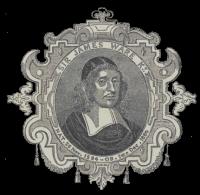
Portrait of Sir James Ware from the frontispiece of James Henthorne Todd’s 1864 edition of the Martyrology of Donegal. (UCD)
Sir James Ware: background
Ware undoubtedly fits the stereotypical mould of the ‘New English’ colonist—a devout Protestant, staunch royalist and government official. Born on 26November 1594 at Castle Street, Dublin, he was the eldest surviving son of English parents who came to Ireland in 1588 in Lord Deputy Sir William Fitzwilliam’s train. His upbringing reflected a firm commitment to the established church: he regularly attended St Werburgh’s; he married Elizabeth Newman, whose father later became clerk of the rolls; and he attended the recently founded Protestant university in Dublin, Trinity College. There he received a BA in 1611 and an MA in 1628.
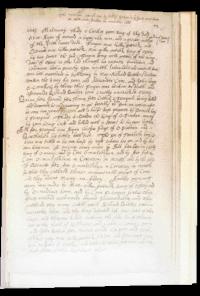
‘This translation beginned was by Dodly fferbisse in Sr James wares house at Castle-street, Dublin. vi. novembris. 1666’—opening page of Ware’s copy of the Annals of Ireland, 1443–68, which was translated from Irish by Dubhaltach Mac Fhirbhisigh. (British Library)
‘An industrious searcher of ye antiquities’
For all of Ware’s political accomplishments, it is his scholarly achievements that distinguish him in the long term. Over a 40-year span, he published eleven substantial historical works. These drew on an extensive range of manuscript sources, predominantly in Latin and English, having as their primary objective the promotion of Ireland’s rich heritage. He developed a taste for history at an early stage, thanks largely to the influence of his mentor at Trinity College, James Ussher, later archbishop of Armagh. In a letter dated 10 July 1620, Ware enthusiastically informed him of his intentions ‘to insert the obits of some b[ishop]s of Ardmagh according as I found them in an ould MS [manuscript] (w[hi]ch as I take it might be fitly called the Annals of the North, as treating thereof principally)’.
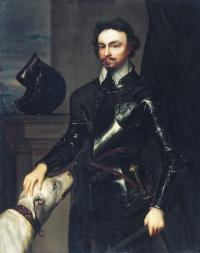
Lord Deputy Wentworth—appointed Ware to the Irish privy council in 1640. (National Portrait Gallery, London)
Scholarly community
Ware’s scholarly contribution to Irish history brought him into contact with a wider academic community. Dempster’s Historia ecclesiastica gentis Scotorum, which caused outrage among Irish scholars, came into Ware’s possession thanks to Bishop Rothe. Ware also borrowed from him the Register of Kells priory, among others, for his studies on the Irish episcopate, and looked to Rothe’s brother, Robert, to acquire the Annals of Friar Clynn. Such levels of collaboration demonstrate the mutual respect that existed between men on opposing sides of the religious divide. In August 1628 the Franciscan Thomas Strange wrote to Wadding:
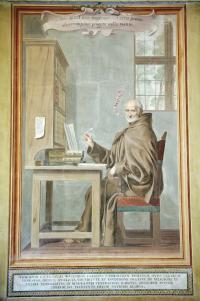
Luke Wadding OFM—David Rothe, Catholic bishop of Ossory, wrote to him in Rome that ‘Sir James Ware’s paynes for Dublin, Cassill, and Tuam, and the Cistercian abbayes in print may serve to some sted’. (St Isidore’s College, Rome)
‘I have a friend (even though he is a Protestant) who examines antiquities. He wrote de Archiepiscopis Casselensibus et Tuamensibus and de Praesulibus Lageniae; whatever point of curiosity or antiquity that your Paternity would like to know, let me know, because he has given me his word that he will authenticate the originals insofar as he is Custos Rotulorum here, a very good man, and I hope he will prosper; he is a close friend of mine.’
It is almost certain that their working partnership brought Ware into contact with Mícheál Ó Cléirigh, the chief compiler of the Annals of the Four Masters, who was based in the Irish college in Louvain. Indeed, Bernadette Cunningham makes a compelling case that Ó Cléirigh did some work for Ware when he visited Dublin in February 1637.Ware’s network also encompassed members of the Catholic laity. Among them was John Rochford of Kilbride, with whom he exchanged registers and books of obits. It is possible, moreover, that John was an intermediary between his cantankerous brother, Luke, and Ware. Luke was a secular priest who received his training on the Continent and subsequently published The genealogy of protestants in 1622 in Paris, refuting the claims of reformed religion. It may not have been to Ware’s personal taste, but the book would still have been of use for his research in ecclesiastical history. His association with Dr Thomas Arthur of Limerick is no less interesting. An ardent Catholic, Arthur was a physician who had keen literary interests, particularly in devotional texts. In 1627 Ussher lent him a copy of the best-known Irish collection of saints’ lives, the Codex Kilkenniensis. But given that Ware had possessed the manuscript, and that he and the archbishop were patients of Arthur, Ware probably had some involvement in the transaction. Furthermore, there are other indications that Ware and the doctor exchanged material. Both men took an interest in the sixteenth-century mayor of Limerick, Edmund Sexton, the city’s first official of native Irish extraction. Among Ware’s manuscripts are letters relating to Sexton’s appointment—correspondence that is also in the Arthur manuscripts in the British Library.But perhaps none of the numerous scholarly associations were as significant as his links with influential Gaelic scholars. They played a vital role in his research, providing him with access to important Irish annals. He befriended Brien Mc Murrogh Roe of Wicklow, who had in his possession the Martyrology of Irish Saints; Edward Ó Cruitin from Thomond, who owned the Cashel Psalter; and Conall Mageoghegan from Westmeath, who translated the Annals of Clonmacnoise, which contained essential information on the history of the Gaelic lordships on either side of the Shannon. His rapport with Dubhaltach Mac Fhirbhisigh from Sligo was even more remarkable. In 1665 Ware employed him to make translations of Irish material from sources including the Book of Lecan, the Annals of Innisfallen and the Annals of Tigernach. They had clearly formed a close bond. In the opening paragraph of his list of 140 early and medieval Irish bishops, Mac Fhirbhisigh addressed it to the ‘Right Worshipfull and Eever Hono[u]red Sir James Ware’. Their friendship was still in evidence a year later, when the Gaelic scholar noted that he began translating an Irish chronicle at his patron’s house in November 1666. Mac Fhirbhisigh may even have been living with Ware when the latter died the following month.
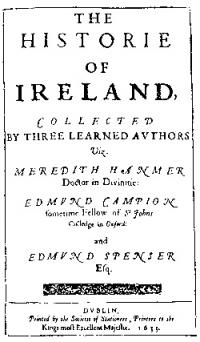
Title-page of Ware’s The historie of Ireland (1633)
Ware’s relationship with Catholic clerics and Gaelic scholars is just one aspect of his extensive scholarly network. A cursory examination of his manuscripts reveals that he shared his books with government officials, Protestant bishops and even interested laymen, who can be identified in the Church of Ireland parish registers. Nor were his connections limited to Ireland. He was in regular contact with the great English antiquarians of his day, particularly Sir Robert Cotton and Sir William Dugdale, and there is also evidence that he communicated with the French antiquarian and religious controversialist Samuel Bochart when he was in exile in France. But the crucial point is that his network demonstrates the extent to which antiquarian researches criss-crossed ethnic, religious and political divisions in a period of enormous tension. He was not by any means unique in this endeavour. Excellent work by Raymond Gillespie, Bernadette Cunningham and Brian Mac Cuarta has shown that there were other Protestant figures who interacted cordially not just with Catholics but also with representative scholars from the Gaelic world. The time is surely overdue for a radical reassessment of current historiographical models that predicate cultural, ethnic and religious apartheid in this intellectually vibrant period of Irish history. HI
Mark Empey is an IRCHSS postdoctoral fellow at UCD Humanities Institute of Ireland, where he is working on the project ‘Protestants, print and Gaelic culture, 1567–1722’.
Further reading:
B. Cunningham, The Annals of the Four Masters (Dublin, 2010).B. Mac Cuarta, ‘A planter’s interaction with Gaelic culture: Sir Matthew De Renzy, 1577–1634’, Irish Economic and Social History 20 (1993), 1–17.N. Ó Muraíle, The celebrated antiquary: Dubhaltach Mac Fhirbhisigh (c. 1600–1671): his lineage, life and learning (Maynooth, 2002).W. O’Sullivan, ‘A finding list of Sir James Ware’s manuscripts’, Proceedings of the Royal Irish Academy 97C (1997), 2–99.
The author would like to thank Susie Hayes for her assistance in translating Spanish documents.
















